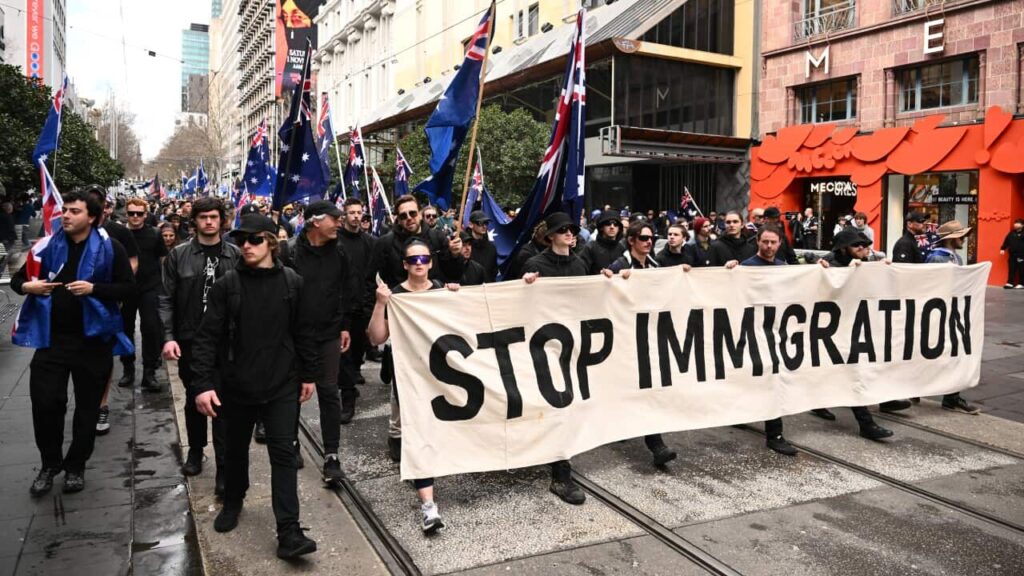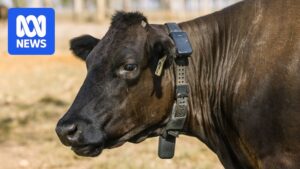
On Sunday, thousands of Australians took to the streets in anti-immigration marches, with prominent figures like One Nation leader Pauline Hanson and federal MP Bob Katter addressing the crowds. The rallies, held across various cities, were organized under the banner of “March for Australia” and aimed to “take back” the country amidst growing concerns over immigration policies.
The rallies, however, were marred by controversy as organizers attempted to distance themselves from neo-Nazi groups. Despite these efforts, Thomas Sewell, leader of the National Socialist Network (NSN), was seen speaking at the Melbourne rally. Similarly, in Sydney, the leader of White Australia NSW addressed attendees, further complicating the narrative of the march.
The demonstrations were met with counter-protests, leading to heightened tensions. In Melbourne, police resorted to using pepper spray and mounted units to keep opposing groups apart. At the core of the ‘March for Australia’ was a call to end “mass migration,” which organizers claimed has “torn at the bonds that held our communities together.”
Assessing the Claims: Migration Statistics Under Scrutiny
In the lead-up to the marches, promotional materials and some media outlets circulated various claims about Australia’s migration statistics and policies. These assertions have since been subjected to scrutiny by experts and fact-checkers.
Claim: ‘More than 1,500 Migrants Arrive Daily’
One claim, highlighted by 2GB radio host Ben Fordham, suggested that 1,544 migrants, equivalent to five fully-loaded Boeing 787 Dreamliners, arrive in Australia daily. Fordham argued this influx justified the ‘March for Australia’ protests, estimating this would result in 457,000 new arrivals over the 2024-25 financial year.
“At this pace, in just three years we will add 1.4 million people, and that’s around the population of Adelaide,” Fordham stated.
However, the Australian Bureau of Statistics (ABS) refuted these figures, explaining they are based on overseas arrivals and departures data, which often overestimates net migration. Abul Rizvi, a former deputy secretary of the immigration department, clarified:
“Many people who are long-term in Australia, such as students, are going in and out frequently. Each time they go in and out, they keep getting counted. So it can throw things about a lot,” Rizvi said.
The ABS is set to publish updated population figures for the March quarter of 2025 on 18 September, which may provide further clarity.
Claim: ‘More Indians in Five Years than Greeks and Italians in 100’
Another contentious claim singled out the Indian community, suggesting more Indian nationals have migrated to Australia since 2020 than Greek and Italian arrivals since 1925. This assertion, appearing on flyers distributed by march organizers, lacks accurate historical data for verification.
Peter McDonald, an emeritus professor of demography at the Australian National University, described the claim as “an odd statement to make.” He noted that while Indian arrivals have increased, they are comparable to Greek and Italian post-war migration when considered as a percentage of the overall population.
“Over the 25 years following World War Two, Greek-Italian migration averaged around 0.2 per cent of Australia’s population per year. Meanwhile, over the past 20 financial years, net migration from India has averaged around 0.22 per cent each year,” McDonald explained.
McDonald also highlighted that similar narratives targeted Greek and Italian communities in the past, reflecting a historical pattern of xenophobia.
Exploring the ‘Replacement’ Theory and Public Opinion
The rhetoric of the marches also included claims of “replacement,” a notion linked to the “great replacement theory” espoused by Christchurch terrorist Brenton Tarrant. This extremist narrative suggests a deliberate agenda to replace populations of European descent through migration.
Abul Rizvi dismissed this theory as fundamentally flawed, noting that the increase in Indian migration is largely due to Australia’s selection of skilled migrants, many of whom possess strong English language skills.
“They have a high level of English, and English is a big factor in skills and stream selection,” Rizvi said, adding that not all Indian arrivals remain in Australia permanently.
Claim: ‘The Majority is With Us’
March for Australia organizers cited a Lowy Institute poll indicating that 53 percent of Australians believe the number of migrants is “too high.” However, this statistic requires context. The Lowy Institute also found that 69 percent of Australians view cultural diversity as a positive aspect of the country.
Rizvi pointed out that migration numbers are already declining, with estimates suggesting a drop to the 300,000s, down from a post-COVID peak of 536,000 in the 2022-23 financial year. Despite this, Rizvi predicts immigration will exceed Treasury’s forecast of 260,000 migrants, which was later adjusted to 340,000.
“Treasury have got the forecasts wrong now in the last two to three years and it has created a lack of trust in their forecasts,” Rizvi commented.
The Broader Implications and Future Outlook
The March for Australia rallies and the claims they propagated highlight a broader debate on immigration in Australia. As the nation grapples with these issues, it is crucial to rely on accurate data and informed discourse to shape policy and public opinion.
With the ABS set to release updated migration statistics and ongoing discussions about the role of immigration in Australia’s future, the conversation is far from over. As experts continue to analyze the data, the challenge remains to address public concerns while fostering a diverse and inclusive society.






